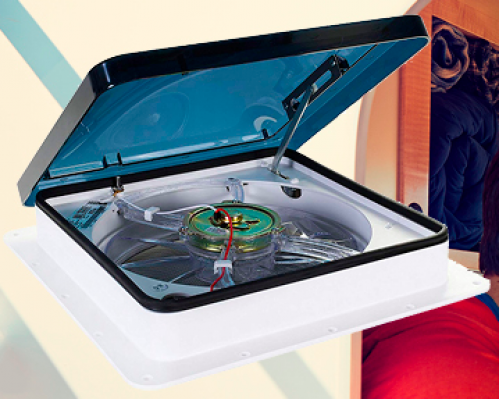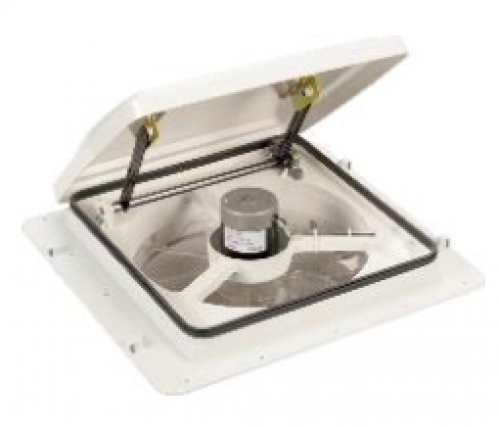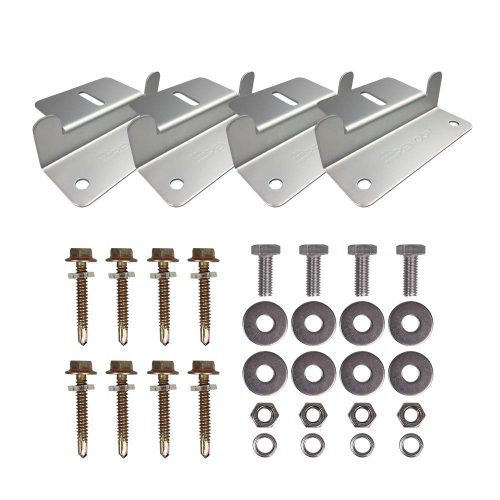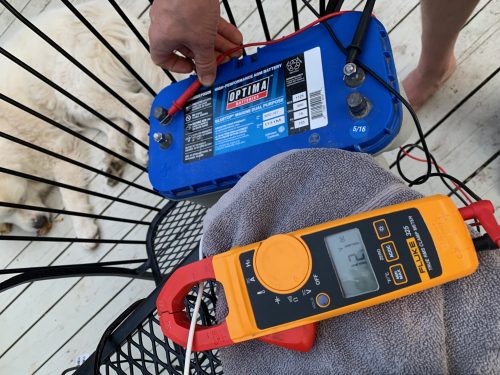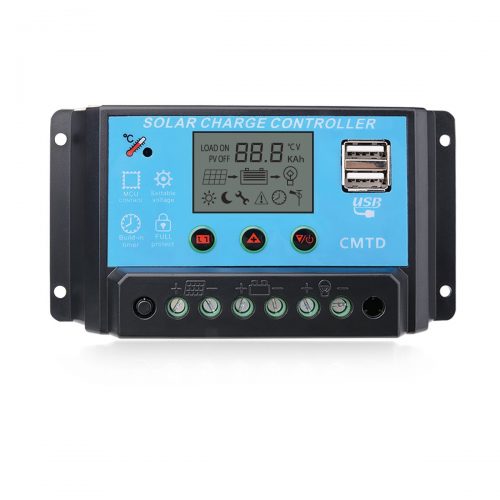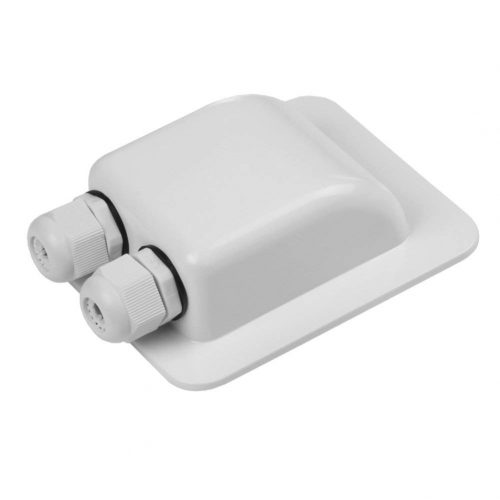
We reviewed every popular 12v roof exhaust fan, batteries, solar panels, and charge controllers to find the best solar powered RV Vent Fan system.
Whether you need to remove hot, stale, or smokey air from your van, RV, tiny house, or garage – these systems will work great.
So if you want to get rid of stale air and bring fresh outdoor air in, these roof vents will do the trick.
Solar exhaust systems require three main components:
- The Exhaust Fan Itself Removes Hot Air
- The Solar Panel Generates Power
- The Batter Bank Stores Energy
- The Charge Controller Keeps The Components Safe
If you already have deep cycle batteries (not your main starter battery) you should have no problem running your exhaust fan from it. You could also put off the solar panels and charge your deep cycle battery off your alternator with a battery isolator (important).
This is a good strategy that works great if you are driving daily. It also gives you the option to add solar later. The same exhaust fans below work for both setups.
We’ll also discuss all-in-one solar exhaust fans that power the fan directly from the solar panel. While this will allow you to power your fan without a battery or charge controller, you will be limited to running the fan during the day when the sun is out.
If you’ve ever spent a hot, muggy night in bed knowing that it’s colder outside than inside, you know why a battery system is so important.
Best 12v Exhaust Fans
Best Exhaust Fan For Vans and Low Ceilings
If you can easily reach your exhaust fan, don’t overcomplicate your project with needless remotes, motors, and sensors. Keep it cheap, simple, quiet, compatible, and efficient with our #1 choice for vans.
9.6Expert ScoreFan-Tastic 1200 Exhaust Vent
This remarkably efficient fan almost blew us away when we first tested it at Off Grid Labs. It's no wonder the Fan-Tastic exhaust vents have such a large fan base.
Efficiency
10
Installation
10
Compatability
10
Features
6
Noise
9
Positive
- Installing the Fan-Tastic 1200 is a breeze. It comes with a Self-Sealing Cover and great instructions that make it a great DIY project with almost no risk if you take your time and read the instruction.
- Multiple Fan Speeds allows you to manage your battery reservoir to make sure it will last through the night. It also gives you the opportunity to crank it up and rapidly remove the hot air after the RV or Van has been sitting in the sun for awhile.
- The 1200 is extremely quiet, barely registering on our decibel (dB) reader.
- All the Fan-Tastic vents are extremely efficient. Our tests showed it had the most airflow per watt meaning you will be able to run it longer, or with a smaller battery bank than other brands.
- Screen is durable and keeps the bugs out
Negatives
- The Fan-Tastic 1200 Series has no remote control making it impractical to instal on tiny homes, RVs, or garages with tall ceilings. If you can easily reach the location where you will instal the fan, this is our choice. If you can't reach the installation location, trade up for the Fan-Tastic 7350.
- The 1200 also has no reverse airflow which would allow the exhaust to act as a fan. 99% of the time that's what you want but if not, you're out of luck with this fan. Again, if that's a needed feature Fan-Tastic still has you covered with other models. The 1250, 2250, and 7350 all have a reverse airflow feature.
- Window has been been known to crack with high winds or accidentally driving with vent open.
Fan-Tastic 1200 Vent
★★★★★
Check Price on Amazon
Best price found above.
Fan-Tastic 1200 Conclusion
The 1200 is short on bells and whistles, which honestly makes it even more efficient.
It really is remarkable how many Fan-Tastic owners like to talk about how great they are. They also have a great two year warrenty on all their fans.
If you need the remote control, reversible air flow, motorized vent, and automated rain sensors Fan-Tastic has more expensive models with these features.
However, if you can easily reach the roof of your project, we recommend keeping your exhaust fan as basic as possible.
Keeping it simple will last longer, be quieter, and more efficient.
Regardless of the solar panels, charge controller, and batteries, we recommend starting your solar exhaust vent system with the Fan-Tastic.
Let’s CompareLet’s Face Off The Fan-Tastic 1200 and the comperable Maxxair 4000kFan-Tastic 1200VSMaxxair 4000k
Best Solar Powered Vent/Fan Combo For RVs and Motorhomes
8.9Expert ScoreAirxcell Maxxair Maxxfan Plus 4000k
This popular fan for RVs also has excellent reviews. It's a premium, slightly more expensive product with special features for RV living.
Efficiency
7
Installation
10
Compatability
2
Features
9
Noise
9
Positive
- The Maxxfan Plus has a built in thermostat that let's you program the fan to run when you'll get the most bang for the battery.
- The 10 speed fan lets you really dial in the exact setting desired for based on power draw, temperature, activity, or desired noise. The fan also has a pleasant white noise sound that actually makes it easier for some to fall asleep.
- The Maxxair 400k has built in reverse airflow option that allows the exhaust to act as a fan. This is great when you want to bring in cooler air from above, or if you have two exhaust vents that allow you to bring air in one and out the other for maximum airflow.
- Option for electric opening with the Maxxair 4500 Plus model.
- Best air shield on the market, allowing you to leave the vent open in the rain.
- Tool Free Installation
Negatives
- Requires Maxxfan Proprietary Rain Cover – Make sure to check if it comes with it before buying
- Has extra tabs making it impossible to reuse existing rain cover. Does not play well with others.
- Screen rusts early and may need to be replaced.
- Poor customer service reported
Maxxair Maxxfan Delux 7000K Exhaust Vent / Fan Combo
★★★★★
Amazon (Best Price)
Best For RVs Without Reachable Ceiling Or For Convenience
- Remote Controlled Operation
- Automatic Open and Close
- Lid Closed Operation
- Rain Cover
- Thermostat
- 10 Speed Fan
- Exhaust and Fan Modes
- White Lid
- Backup Control at Fan
Maxxair Maxxfan Plus 4000k Exhaust Vent / Fan Combo
★★★★★
Amazon (Best Price)
Best For RVs With Reachable Ceiling
- Lid Closed Operation
- Rain Cover
- Thermostat
- 10 Speed Fan
- Exhaust and Fan Modes
- White Lid
- Keypad Control at Ceiling
- Opens Manually
Best RV/Van Exhaust Vent On a Budget
5.5Expert ScoreVentline RV Roof Vent
On a budget? This fan will get the job done and you can always upgrade later. The main drawback is the small fan that doesn't cover the entire opening, so you will not be moving nearly as much air with this fan.
Efficiency
4
Installation
9.6
Compatability
9.3
Features
4
Noise
4
Positive
- At under $40, the Ventline RV roof vent is your best option on a budget.
- Comes with a galvanized metal flange that may be more durable than the more expensive model flanges.
Negatives
- Fan itself is quite small and will not push nearly as much air as the Fantastic or Maxxair models above.
- Only one speed, on or off. No other models or upgrades to choose from.
Ventline RV Roof Vent
★★★☆☆
Amazon (Best Price)
Best for small Vans on a budget.
- Galvanized metal flange
- 12v DC Fan
- Includes garnish ring, screws, and putty tape
- Aerodynamic lid
Our Hot Take: Your roof exhaust requires significant work to cut the hole, run wiring, and install. This is not the best place to save $100. We recommend getting a higher quality fan above that you hopefully won’t have to replace.

Nick Swanson
Mobile Solar Expert
Best Solar Panels For Your RV Roof Exhaust
We recommend rigid, 100 watt solar panels in the range of 17-19 amps for any RV, Van, or Tiny House system to work with your 12v system. Almost any charge controller will knock the voltage down to the sweet spot for your batteries, they fit well on any roof, and are easy to install and expand.
We do not recommend flexible solar panels that are popular on RVs and Vans because they will not last as long, are more expensive, and are less efficient. Solar panels need space underneath them to properly cool and run at maximum efficiency!
Newpowa 100 Watt Solar Panel
These solar panels are currently the best bang for your buck, check the latest price, but if they are under 85 cents/watt with free shipping you have a great deal.
Renogy Solar Panel Hardware
This hardware kit makes it a breeze to instal any solar panel on a metal RV or Van roof.
Best Battery for Van and RV Solar Roof Vent System
Your solar panel can only generate electricity to power your solar panel during the day, which may or may not be when you need it. The roof exhaust vent is most magical at night when outside air is cooler than the inside temperature. You need a battery to store the solar energy (or alternator energy) for use at night when you’re trying to sleep.
The roof vents above do not require much energy (30-50 watts or so max) and therefore can run off almost any decent deep cycle battery all night.
The biggest factor when selecting a battery for your fan will be if you anticipate expanding the system in the future to include things like solar powered lighting, appliances, more fans, entertainment systems, chillers, etc.
Best Battery for Powering Your Solar Vent
9.8Expert ScoreOptima Blue Vent Starting and Deep Cycle Battery
These are not the cheapest option but are the best for beginners as they can take a lot of abuse, can't off-gas, and play nice with solar panels, charge controllers, and fans.
Off-Grid Labs has been testing these batteries with pumps, motors, and fans and they are outperforming many deep cycle batteries more commonly used in RVs and Vans.
Round Trip Efficiency
9
Installation
9.6
Compatability
10
Positive
- These deep cycle and starting batteries are designed to handle just about anything. They can handle heat, moisture, fast discharging, deep cycles, and more. You're unlikely to damage these batteries.
- AGM battery technology means these do not off gas when charging like lead acid batteries. This allows you to safely place them inside your van or RV without worrying about venting the battery box. Just make sure to strap them down well.
- Can be mounted on its side, with almost no extra setbacks or mounting restrictions.
- Can be used to start your vehicles battery if necessary, while most deep cycle batteries are not built for such rapid discharge.
- Very Low Self-Discharge Rate meaning they will not loose a lot of power sitting unused without being charged for awhile.
Negatives
- At 60 pounds each these are heavier than most. For a simple fan setup you only need one, but they can get too heavy if running a large battery bank.
- Poor customer service and consistency reported by reviewers.
- Reports of battery only lasting a year or so, but likely due to extreme overuse or battery depletion. Batteries should never be discharged over 50%, and will last longer if only using 20%. There are also reports of these batteries lasting 4 plus years, which is closer to what we are experiencing at Off Grid Labs.
- Reports of batteries freezing in extreme cold.
- Not good for budget buyers, may be overkill for basic solar setups.
Optima Blue Top Starting and Deep Cycle Batteries
★★★★★
Check Price
- AGM Battery
- Deep Cycle and Starting Combo
- 1125 MCA
- 900 CCA
- 75 Amp Hours
- 155 RC
Renogy Deep Cycle Batteries
Renogy makes awesome batteries for RVs that have a triple sealed gel technology that can be left inside the van. Again, avoiding lead acid makes your installation much easier.
These are serious, 100 and 200 amp hour pure gel batteries that should last for years. These are a great choice for tiny homes or mobile rigs with high power demands, such as RVs and vans that stay parked off the grid for extended periods without shore power.
Renogy batteries also boast an extremely long service life, of up to ten years with optimal float charge conditions. Float charge ensures the battery is always full and happy, and most charge controllers have this function.
Even without optimal float charge, the battery looses just 3% per month with is great for gel and lead acid batteries.
Renogy batteries are often used to power entire houses, so you will have no problem expanding your system as your needs grow to include things like water heaters, air conditioning, and large refrigerators. Just make sure you have enough batteries to keep from discharging below 80%.
Renogy Pure Gel Deep Cycle Battery
- 12v Gel battery – can be placed on side, indoors, and unvented.
- 100 AH
- 110 Cycles
- 60 Pounds
Best Charge Controller For 12v Solar Exhaust Fan
The last main component of your solar roof fan setup will be the charge controller that connects everything together and protects your battery. Never plug a solar panel directly into your battery without a charge controller. You need to give your battery the correct voltage and protect it from overcharging with a charge controller.
Luckily, charge controllers are inexpensive, especially for small solar setups for vans, rvs, and tiny homes.
In fact, you’ll likely end up spending more on cables, connectors, and the entry gland for roof penetrations.
If you’re just connecting a couple 100 watt solar panels, any charge controller should suffice but double check that the amperage and voltage of your solar panels don’t exceed the rating of the charge controller (again, highly unlikely in such a small system).
Best Charge Controller for RV and Van Fan
Sunix Solar Charge Controller
This is under $20 and all you’ll need for most RV and Van setups.
It’s easy to instal, easy to operate, and has USB outputs for running auxiliary lighting or charging 5amp electronics like cell phones.
Good for up to 20 amps solar.
12v or 24v systems (automatic)
Accessories, Connecting, and Installation of Solar Roof Vent
The charge controller is the hub of your 12v solar exhaust system. First, connect the battery to the charge controller, allowing the charge controller to detect 12v or 24v operation mode. It will automatically do this.
Now lay your solar panels in place (don’t install yet) and run cables through desired cable path from panel to charge controller. With panel flipped upside down or covered, connect the panel to the charge controller. Every charge controller we’ve seen is very clear about where to plug in the solar panels and batteries.
Uncover your solar panels and make sure your charge controller recognizes the panels and they are operating as they should.
Now that you know they work, instal the solar panels to the roof of your van, RV, or tiny house. We recommend a mounting system that allows a gap for airflow between the panel and roof which will improve the performance of solar panels.
Now install your exhaust vent and connect the wiring directly to your battery. Do not use the load output of your charge controller – connect directly to battery with a fuse or switch inline if desired.
Operating Solar/Battery Powered Exhaust Vent
Congratulations, you’re ready to experience carbon free cooling.
Exhaust vents work best when it’s cooler outside than inside. With a van or RV, this is almost anytime its been sitting out in the sun with the air conditioning off.
Some exhaust vents (see above) have a temperature sensor that lets you program it to run whenever it’s over a certain temperature inside the RV or Van.
If you have this feature, go ahead and set it to operate when over 100 degrees. Keep it pretty high so it doesn’t operate when no one is using it, which would drain the batteries needlessly.
The most important factor when choosing how much to run your exhaust roof vent is the state of charge of your battery bank. A 12v battery or battery bank should never drop bellow 11.9 volts.
You should be able to monitor your battery voltage on the charge controller. It’s also a good idea to have a good multimeter to check the voltage directly from the battery or solar panel before plugging them into the charge controller (see our favorite below).
The more you discharge your battery the faster your battery will fail.
If possible, keep your battery in the 12.3-12.6 volt range for a lower limit.
Monitor the voltage and turn the exhaust fan off or on low to maintain system voltage.
Don’t Forget The Cable and Connectors
With the main components out of the way, you’ll still need the right cables, mounts, connectors, and a roof gland to run cables through the roof to your charge controller.
Link Solar Weatherproof Cable Roof Gland
If you have solar panels on the roof of your van or RV, you’ll need a gland to penetrate the cables through the roof without creating any leaks or damaging your vehicles shell.
This is the easiest, most reliable gland for a small solar rig and is under $20 with free shipping.
Simple yet effective.
Fluke 325 Clamp Multimeter
This multimeter is not necessary, and rather expensive but if you’re serious about learning how solar power works this is an awesome tool.
You can clamp over any wire and measure the DC amperage flowing in real time.
It’s the best way to experiment, troubleshoot, and instal solar panels, batteries, charge controllers, and DC components.
It’s a pro multimeter easy enough to use for a DIY solar installer.
 MaxxFan Deluxe Roof Vent Review – etrailer.com16:19
MaxxFan Deluxe Roof Vent Review – etrailer.com16:19  Maxx Air Fan vs Fantastic Fan Review. Best Roof Vent for Camper Van and RV11:11
Maxx Air Fan vs Fantastic Fan Review. Best Roof Vent for Camper Van and RV11:11  RV Upgrade | Maxx Air vent cover EASY install! (MADE IN USA) | RV Life09:06
RV Upgrade | Maxx Air vent cover EASY install! (MADE IN USA) | RV Life09:06  How To Install A Fan-Tastic Vent (Fantastic Vent / Fan)13:22
How To Install A Fan-Tastic Vent (Fantastic Vent / Fan)13:22  The Various Types of RV Roof Vents02:55
The Various Types of RV Roof Vents02:55
